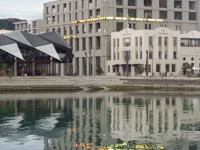Disclaimer Statement: George has family who work at the University of Otago Wellington.
I like it when the Health Research Council (HRC) funding round is announced. Partly to see if anyone I know got funding (see Disclaimer Statement above) but mainly for selfish reasons. I love the way the two universities with medical schools rapidly flick out press releases saying the results show they (and not the other lot) are the leaders in New Zealand health research. My favourite was the year that one came out trumpeting themselves as the leader because they got the most projects funded and the other because they got the most money. There wasn’t much in it.
But now it seems the word is ‘loved.’ The results came out last week and neither University tried to laud it over the other. Both press releases, here and here, were interesting and informative but even taken together they weren’t amusing at all. Intentionally or otherwise. Perhaps the days of intense competition are over? Or perhaps it was something to do with the numbers.
The HRC don’t put their results on the website as a table (you can take that as a hint if you like) so those of us with an affection for the “Sumif” function have to make our own. They don’t put them out in institution order either so it took a while for the penny to drop: an awful lot of the winners had Wellington in the address line. In fact, in percentage terms the distribution of funding looks like this:
| City | % of Total |
| Wellington | 35 |
| Auckland | 31 |
| Dunedin | 23 |
| Christchurch | 9 |
| Palmerston North | 1 |
I can’t remember a year when Wellington got more funding from the HRC than Auckland. Not in the main round anyway.
Last year the Malaghan Institute in Wellington did well with $14 million and the Medical Research Institute of New Zealand (MRINZ) also got $6.8 million from the HRCs new (and possibly one-off?) Capability in Independent Research Institutes Fund. The main round bought another $6 or so million into the city (more than half of it for the Malaghan).
This year, without the Capability Fund I couldn’t see how the town could do so well again. But it did. Between them, the University of Otago Wellington, MRINZ, Massey’s Wellington Campus and Victoria University were awarded $21 million. The Wellington campus of Otago was awarded $11 million on its own – not far off the $14 million that went to the Mothership in Dunedin. I am told that the Wellington Head of Campus (see disclaimer above) described their success as a ‘staistical blip.’ Even if that is true, in the last couple of years Wellington has signed contracts with the HRC for $40 million. That’s a lot of money and there will be more added to it next year.
That’s because Wellington is growing as a centre for Medical Research in New Zealand. The Wellington School of Medicine (which now makes up most of the Otago campus in Wellington) and the Malaghan have been around for a while and have an established reputation. MRINZ, Massey and Victoria are building their strength in medical research. The Gillies McIndoe Research Institute, based around superstar surgeon Swee Tan, is a relatively new player in the research landscape and the Capital and Coast DHB have also been building their research capacity over the last few years. It was notable in the HRC numbers for this year that Wellington had more successful organisations than any other centre.
There are other health focused groups in the region as well that don’t tend to show in the HRC funding; Callaghan Innovation Research gave one of the country’s leading drug development groups, Richard Furneaux’s Ferrier Institute to Victoria, but hung on to the commercial Good Manufacturing Practice drug synthesis facility Glycosyn. The CRI ESR manages health science and infectious disease research out of ts sites in Kenneperu and Wallaceville, and the Hutt Valley DHB also conducts research, not all of it through its links with the Otago Campus.
So research-wise the region has critical mass (and now $40 million). The air is a thick with shared history (the family tree for the research groups looks a little Game of Thrones) so collaboration isn’t always straightforward but it’s getting there. What Wellington really lacks is industry. I was at a meeting recently run by Callgahan Innovation’s National Biotechnology Network Manager to look at what the sector needed and someone pointed out there were a lot of ‘providers’ and not many ‘purchasers’ for the Wellington discussion. Indeed. We have Matakina, some players in the natural health products sector such as Honeylab, testing at Trinity Bioactives, and the ever self-effacing AroTec and BDG. This may change though with the Malaghan and Ferrier combining to spin out Avalia Therapeutics and now that powerHouse Ventures, the most active of the new Technology Incubators, is getting going on the Callaghan Gracefield campus more may follow.
Patriotism (or in this case parochialism) may well be the last resort of a scoundrel but it is nice to see Wellington’s investment in health research begin to pay dividends and and maybe even get recognition alongside the city’s tech sector.
And why were those press releases so much less fun than usual?


